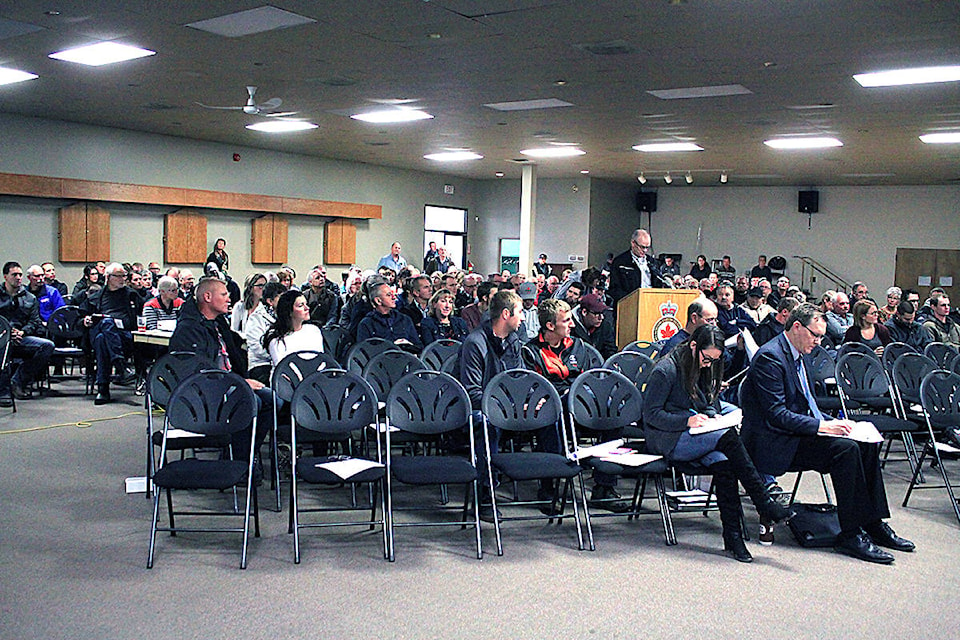Despite a public meeting in August and significant changes to the area covered by the plan, the opposition was loud and came in force.
The auditorium at the Ponoka Legion was nearly packed Oct. 2 for Ponoka County’s public hearing into the revised North West Area Structure Plan (ASP). All members of council along with CAO Charlie Cutforth and planning consultant Bob Riddett were at the hearing to listen and speak to the subject.
The ASP exclusion zone has been reduced from its original version that was revealed in August. Now it encompasses the region bordered by Highway 2 to the Battle River to Highway 53 and Township Road 441. One other change is that the county is committed to no more new multi-lot subdivision approvals within the area, with possible exceptions along the river valley.
Cutforth did explain some of the rationale behind the plan before the public comment session, noting there had been three confined feeding operation (CFO) applications to the Natural Resources Conservation Board (NRCB) within the plan area in the last two years that has been strongly objected to by neighbours.
“(These objections) were primarily based on the number of operations already located in the area. The NRCB response to the objections was that the county could create plans that would control the number of operations in a specified area and approving officers would be required to recognize them,” he stated.
Cutforth also reiterated that all agricultural operations in the county are important and valuable, along with helping drive the local economy, to the point that existing operations could still expand within the NRCB guidelines.
“This plan is simply intended to maintain balanced land use in an area that has experienced conflict between existing residents and new CFO applicants. It doesn’t restrict or impede existing operations from continuing to operate or expand,” he added.
Once the floor was opened up to the public, just three speakers came up in favour — concerned with water quality and noting agricultural operations are not being limited.
Among those was Doug Hart, who questioned a couple of opposition concerns.
“The NRCB has less an understanding of the county than our council and any information council can provide would be a supplement,” he stated, adding CFOs will also be impacted less economically by the plan than small farms and acreage owners.
“I also don’t view it is a ‘thin edge of the wedge’ issue, at some point there might be a structure plan developed east or west and I don’t see that as limiting the CFOs, as much as I see it as a prudent future, sustainable plan.”
Over on the other side of the fence, several existing CFO owner/operators along with the co-creators of the recently started Right to Farm Society (RFS) took to the microphone — most hammering the county for messing around where they state the NRCB is already doing a good job in regulating the situation.
Pim Spelt lamented the fact people no longer think of the community, but just of themselves, as well as why the county feels the need to restrict him from making a living.
“You are elected officials, you have to look at both sides. I built my first CFO in 1996, under the regulation of the municipality and built a new one under the NRCB,” he said. “We have our regulations, why Ponoka County? I’m not in this plan, but I’m probably in the next one.”
Other speakers expressed displeasure with how the ASP appears to eliminate the family farm and impose further regulations on an industry that the NRCB already highly regulates, while RFS co-creator Karen Pierik, in an impassioned slide presentation, focused on the alleged concentration issue.
“Modern farming can co-exist with country residential, if we all realize there will some level of impact. We need to start talking about agriculture and its importance,” Pierik explained, who added the residential concentration in the ASP is not any different than in other regions of the county.
“It’s the same amount of residents across the county. Congestion, no. I looked where I could spread out that is any different than the North West. If you can justify doing it there, you can justify any area.
“We want to collaborate, we want to work together, but we also want food. If you can’t farm in the north west, you can’t farm anywhere.”
No decisions were made at the hearing, however, council will make a decision at its Oct. 9 meeting.
jordie.dwyer@ponokanews.com
Like us on Facebook and follow us on Twitter
